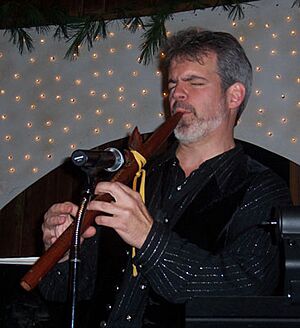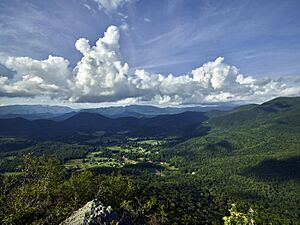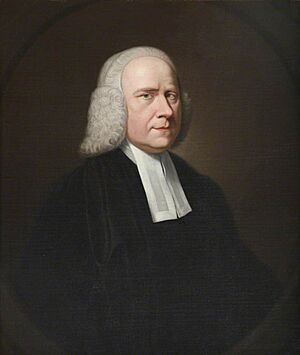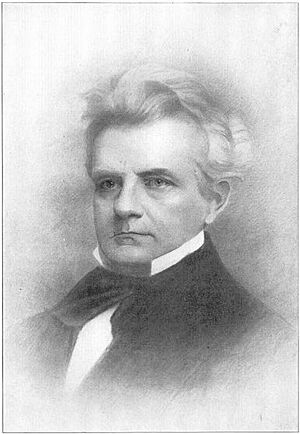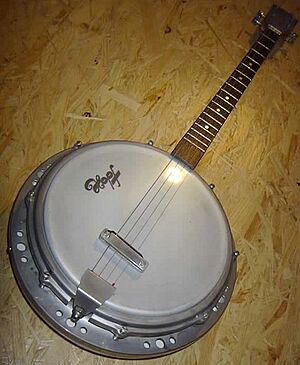Music history of the United States during the colonial era facts for kids
The story of American music began way back in 1607, when the first European settlers arrived in Jamestown, Virginia. From the very start, music in the United States has been as diverse as its people. Native Americans had their own spiritual songs, and African people brought instruments like the banjo and xylophone.
In New England, music was often very religious. It played a big part in shaping early American sounds. As people moved south, they settled in the Appalachian Mountains. Here, many European settlers brought their country blues and fiddling styles. Religious hymns were also very popular everywhere. Groups like the First New England School, Shakers, and Quakers became famous for their religious music and dances.
In 1776, the St. Cecilia Music Society opened in Province of South Carolina. This led to many more music groups starting up in the Northern United States. African slaves also introduced new instruments like drums and the banjo. The amazing mix of music in the United States truly comes from all the different people who first lived here.
Contents
Native American Music
Native Americans had a rich musical tradition, but it was different from European classical music. Their music was usually spiritual and performed in groups as part of important religious ceremonies.
It wasn't until the late 1800s that Native American music started to be recognized by the wider American public. Around this time, new cultural events like powwows began. Some composers, like Edward MacDowell, even started using Native American themes in their music. Later, Arthur Farwell helped bring a more accurate understanding of Native American music into the American classical scene.
Appalachian Folk Music
The Appalachian Mountains have always been a special place for new ideas in music. Even though not many Native Americans or Europeans lived there at first, the mountains were hard to cross. This meant that many poor Europeans, including English, Scots-Irish, German, and Huguenot people, settled there between 1775 and 1850.
These settlers brought their English, Anglo-Irish, and Scottish songs and stories. These tunes changed over time in the Appalachians. They became the foundation for jug bands, country blues, hillbilly music, and eventually country music. These folk songs mixed ideas from different places. For example, British story-songs (called broadside ballads) changed from being about love to focusing on American themes like mining work or exciting disasters. African folk tunes, which often told stories about real events, also added to this mix. Popular songs included "Barbara Allen" and "Matty Groves". The banjo, an instrument with a long history from Arabia and Africa, also became very important here.
Fiddling Styles
Fiddle playing in the Appalachians mostly came from styles brought by English settlers. Some people thought a special "Scotch snap" from Scotland influenced it, but historians say English, Scottish, Irish, and American fiddle styles grew up together like "cultural cousins." Over the next hundred years, European waltzes and polkas also influenced Appalachian fiddle playing. Square dances and cakewalks (an African American dance that copied white dances) became popular in the 1800s.
Lined-Out Hymns
Lined-out hymnody is a religious music style used by groups like the Old Regular Baptists. It's often studied as a type of folk music. In this style, a leader sings one line, and then the congregation sings it back.
New England Colonial Music
Religious singing in New England was very important in the early days of American music. The Pilgrim colonists brought their Ainsworth Psalter (a book of psalms) with them. Church hymns were popular everywhere. Regular people in New England soon created their own singing traditions.
New England Choral Traditions
The first Puritan settlers in New England sang many spiritual psalms. They generally didn't like non-religious music, especially if they thought it encouraged bad behavior. They also didn't like musical instruments in churches or complicated singing styles, because these were linked to the Roman Catholic Church.
A famous minister named Cotton Mather wrote about music, saying it was okay if it helped you serve God better. He also said that learning "Regular Singing" (a more organized way of singing) would be useful every day.
The Ainsworth Psalter provided most of the tunes for New England churches until the late 1600s. Then, people found the tunes too hard to sing.
The Bay Psalm Book was the first book printed in the English colonies in North America in 1640. It became the main book for New England churches for many years. It had psalms but no music. Later, in 1651, a new version called the New England Psalm Book became the standard. In 1698, the ninth edition was the first to include printed music notes. Over time, the number of tunes used in churches became smaller.
The practice of lining out was common, especially when many people couldn't read. A leader would sing one line of a song, holding the first note, and then the congregation would sing the same line back. This method was also used in Appalachian churches.
Organs and Church Bands
Organs were the only instruments used in church music back then, and even that caused arguments! In many Puritan churches, only singing without instruments was allowed. For example, when Thomas Brattle left his organ to a church in Boston in 1713, the church didn't want it and gave it to another church.
Still, organs were used in some New England churches. The first organ made for church use was put in Newport, Rhode Island in 1733. But organs were expensive and hard to play. Only the biggest churches could afford one. So, many churches used smaller instruments like the bass fiddle, which they called "God's fiddle" to tell it apart from the "Devil's fiddle" (the violin). Later, other instruments like the trombone, clarinet, and violin were added, leading to the first church bands.
Everyday Folk Music
For a long time, people thought that religious dislike of non-religious music stopped instrumental folk music in New England. But new research shows that people in Boston owned instruments like the virginals, clarinet, trumpet, flute, and violin.
Even though some ministers didn't like it, dance music was popular in colonial New England, especially by the early 1700s as more settlers arrived.
Broadside ballads were also common. These were printed songs sung to a well-known tune, similar to those in Britain.
Most of what we know about folk music from that time comes from people who thought the songs were rough. So, it's hard to know exactly what they were like. There was a difference between "Regular Singing" (favored by educated clergymen) and the "Common Way" of the folk. The "Regular" singers thought their style was more refined. However, evidence suggests that common people's music was actually more complex, using techniques like ornamentation.
Schools and groups that promoted "Regular Singing" helped it spread, and instruction books were published.
John Wesley's Influence and Spread South
In the 1700s, Americans started writing their own hymns, often based on the Old Testament. The English writer Isaac Watts was also very popular for his hymns. John Wesley, who started the Methodist Church, played a big role in spreading new hymns after visiting Georgia in 1735. Wesley was inspired by the singing of Moravian missionaries. He published a collection of German hymns in 1737.
The Great Awakening
After returning to America, Wesley became an important preacher during a time of strong religious excitement called the Great Awakening. Other preachers like George Whitefield and Jonathan Edwards were also part of this. Wesley and his brother, Charles, wrote many hymns.
Wesley and some other preachers tried to keep their hymns simple. But the Great Awakening hymns spread south and changed from Wesley's strict rules. John Cennick and John Newton were very important in creating these hymns. Newton, a writer who changed his life after a powerful experience, wrote popular hymns about his struggles.
These hymns, sung at large gatherings called camp meetings, especially in the South, became a basis for gospel and blues later on.
First New England School
Compared to older songs, Wesley and other new composers wrote with a simple structure. But farmers and workers in the countryside made these songs more complex. This led to a group of traveling singing teachers, like William Billings, who created hymns that are still sung today. This movement was called the First New England School. Other important composers included Supply Belcher, Andrew Law, and Daniel Read.
The First New England School is often seen as the first truly American music style. A key feature was that male and female voices would double their parts at different pitches to create a full sound, which was new compared to European music.
William Billings was especially important. He was a tanner from Boston who taught himself music. He didn't always follow traditional rules, which made him unique. He taught a famous singing school in Massachusetts in 1774. Some of his students later formed the Stoughton Musical Society, a choral group.
Supply Belcher and Daniel Read were also well-known. Belcher's only published songbook, The Harmony of Maine, included both religious and non-religious songs. Read was a popular musician who made a living selling songbooks. His book, The American Singing Book, was for singing schools that were becoming popular.
These composers helped start a trend of songbook compilers who focused less on religious music. Their songs were often fugues (a type of musical composition) and were sometimes disliked by religious leaders. Andrew Law believed American music should be more like European music. He is known for organizing singing schools and inventing a type of musical notation called shape note.
Shakers
The Shakers were a religious group that started in England in the mid-1700s. They became well-known under the leadership of Ann Lee (Mother Ann). Mother Ann believed in not marrying and had visions that inspired their passionate dances. These dances were part of a spiritual battle. In 1774, Shakers began moving to North America, settling in New England and New York. Even though their customs were unusual, they grew in number and spread south to Kentucky. Mother Ann died in 1784, but Shaker traditions continued. Their most famous dance song is "Simple Gifts".
European Professional Musicians
In 1766, Charleston, South Carolina, became home to the St. Cecilia Society, the first music society in North America. Charleston was a cultural hub, attracting many musicians from Europe. After the American Revolution, northern cities like Philadelphia, New York, and Boston became more important for music. Philadelphia was especially famous for its musical growth, thanks to figures like Alexander Reinagle.
The English singer Benjamin Carr was very important. He arrived in New York in 1793 with his family. They became leading music publishers and sellers, with stores in New York, Philadelphia, and Baltimore. Carr himself was a composer, organist, and pianist. In 1793, they published "The President's March" in Philadelphia, which became a lasting American patriotic song.
The British musician James Hewitt was also a distinguished figure in early American music. He was already famous in London before moving to New York. Hewitt organized concerts and other musical events. His opera Tammany; or, The Indian Chief was controversial because it was the first American opera about Native Americans and was supported by an anti-Federalist group.
Other important European musicians in Boston included the English organist William Selby and the German oboist Johann Christian Gottlieb Graupner.
Gentleman Amateur Composers
In big cities like Philadelphia and Baltimore, European classical music traditions were strong. Philip Phile and Alexander Reinagle were important composers. However, Francis Hopkinson, who signed the Declaration of Independence, is the best-known. One of his songs, "My Days Have Been So Wondrous Free", is often called the first American art song, though it was very similar to European music.
At this time, professional musicians were sometimes looked down upon. Wealthy gentlemen often played music for other rich audiences, but they didn't get paid. In the South, land ownership and slavery were key to a gentleman's life, while in the North, this idea of a landed upper class was less important.
Lowell Mason
Perhaps the most influential early composer was Lowell Mason. From Boston, Mason worked to change how music was taught. He wanted people to learn standard music notation instead of shape notes. He helped publish hymn collections and pushed American music to be more like European music.
Rural Pennsylvania Music
Rural Pennsylvania in colonial times was home to religious groups like the Quakers, as well as important Moravian and Lutheran communities. While Quakers had few musical traditions, other Protestant churches used music a lot in their worship. J. F. Peter came from the Moravian tradition, and Conrad Beissel created his own system of music theory. Lutheran music traditions, like those of Johann Sebastian Bach, were kept alive in Pennsylvania. The city of Bethlehem is still a center for Lutheran music today.
Mennonites
The Mennonites, followers of Menno Simons, settled in Germantown after moving from Germany and Switzerland between 1683 and 1748. They used a hymnbook that was reprinted in Germantown in 1742.
Ephrata Cloister
The Ephrata Cloister was a group of Seventh Day Baptists founded in Lancaster County in 1720. Led by Peter Miller and Conrad Beissel, they believed music was a key part of worship. Beissel created a special music system for the Cloister. Their hymnbook was huge, with over 1,000 hymns, many played with instruments like the violin.
Moravian Church
The Moravian Church started in 1457 and spread across Europe before facing persecution. They moved to America, starting missionary work in Georgia before settling in Pennsylvania, where they founded Bethlehem. A group also moved to Salem, North Carolina.
In both Bethlehem and Salem, Moravians continued to use music in their ceremonies. They used organs and trombones, and often sang in choirs. Players would even play on rooftops so their music could be heard far away. There's a story that during the French and Indian War, Native American warriors approached a Moravian settlement but left after hearing a trombone choir, thinking it was the voice of their Great Spirit. Moravians also worked to spread their faith among African slaves and Native Americans. In 1763, they published hymns in the Delaware language.
Moravians also had a tradition of non-religious art music. The famous composer Johann Friedrich Peter moved to Bethlehem in 1770. He brought copies of music by famous European composers like Joseph Haydn. After moving to Salem, he started the Collegium Musicum in 1786 and collected many symphonies and anthems. Peter also wrote respected instrumental pieces and sacred songs.
The Moravian Church continued to produce many famous composers into the 1800s, including John Antes. The Moravian Music Foundation in Salem has helped make their vast musical archives public.
Pietists
In 1694, Johannes Kelpius brought a group of German Pietists to Pennsylvania. They were known as the Hermits of the Wissahickon. Kelpius was a musician, and he and his followers used instruments in their church life. Kelpius is sometimes called the first Pennsylvanian composer, though the tunes for his hymns were mostly based on German songs. Christopher Witt, an Englishman who joined the mystics, built them a pipe organ, which was said to be the first privately owned organ in North America.
In 1703, Justus Falckner, a Lutheran pastor, believed music was very important for missionary work. He even asked for an organ from Germany, thinking it would attract more Native American converts. He wrote hymns like "Rise, Ye Children of Salvation".
Harmony Society
In 1803, a group of Christian pietists led by George Rapp came from Germany and settled in Harmony, Pennsylvania. They formed the Harmony Society in 1805. This group lived communally, believed in peace, and did not marry. Music was a huge part of their lives. The Harmonites wrote their own music and even had an orchestra. The Society lasted until 1906, and their final settlement, Old Economy Village, still has their sheet music, which is performed at special events today.
African Americans
African slaves were brought to the United States as early as 1619 from many different tribes in West Africa. They spoke hundreds of languages and came from various backgrounds.
Slaves brought with them work songs, religious music, dances, and many instruments like the xylophone, flutes, and rattles. A very important vocal style they brought was call-and-response, where a singer and the audience take turns singing lines. This style mixed well with the New England hymn tradition. Another unique feature of African music is that singers often slide into or below notes, rather than starting and ending on a pure note like in Western music.
The most special part of African music is its focus on rhythm. African folk styles are incredibly complex, using many different percussion instruments. These complex rhythms came to the New World with slaves and influenced many American music styles, from African American gospel to pop-swing and rock and roll.
Many slave owners encouraged their slaves to sing while working, thinking it would make them happier and work harder. They usually wanted the songs to be cheerful. This music was often accompanied by a single drum or other objects used for percussion. Since instruments were often not available, clapping and foot-stomping became a big part of slave music. The banjo and various drums were the most important instruments. African slaves also used panpipes, notched gourds (like a güiro), and rattles. The thumb piano was also known.
Black musicians also learned to play European instruments like the clarinet, oboe, French horn, and especially the violin. Wealthy gentlemen often had black slaves as musicians and entertainers. Some became quite famous, like Sy Gilliat in Virginia, who performed at state balls. His assistant, London Brigs, was also a renowned player.
Drums
African slaves in places like Haiti and Brazil kept using drums, and their percussion became a key part of Afro-Caribbean and Latin music. However, in the British North American colonies, drums were often forbidden. Colonial masters feared that drums could be used by slaves to communicate and plan rebellions. Drums did remain an important part of music in the French colony of Louisiana.
Banjo
The banjo was a common instrument in slave life in America. Thomas Jefferson mentioned it in his writings, calling it a banjar and noting its African origin. Other names for it included bangoe and banza. The instrument was described in West Africa as early as 1620.
In North America, the banjo was usually made by hollowing out a gourd and attaching a long neck. Slaves would stretch animal hide, often raccoon, over the gourd and attach four strings. Jefferson said the banjo he knew was tuned to E-A-d-g.
Images for kids


